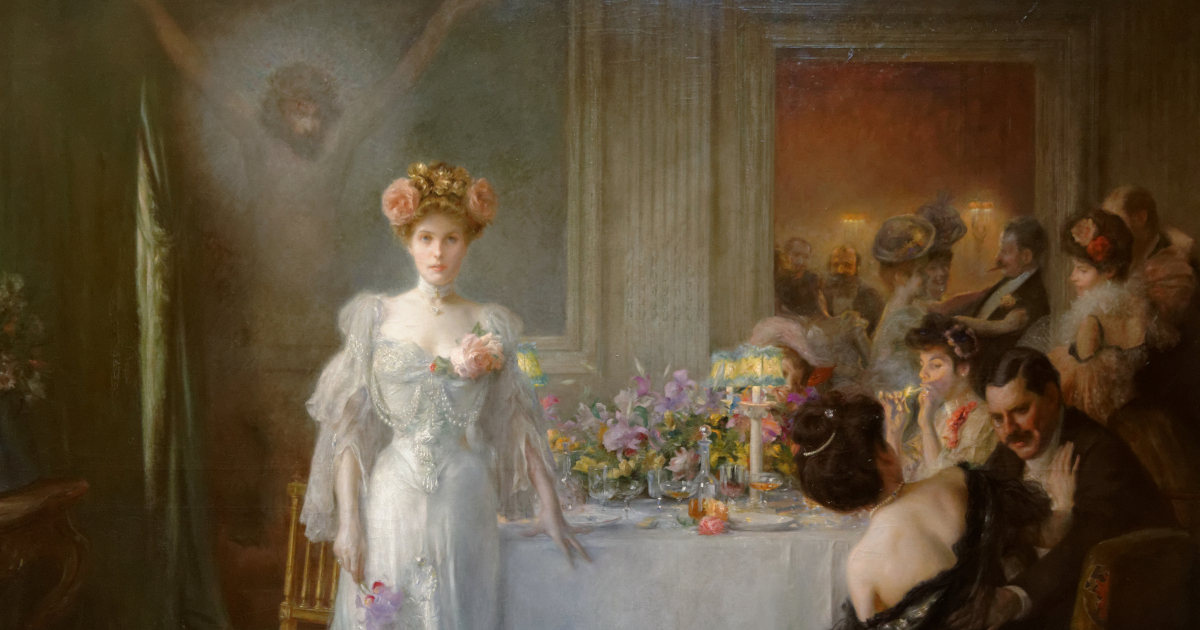Cette publication est également disponible en :
Français
To celebrate the European Night of Museums this saturday, May the 18th, and to invite you to smell artworks, we suggest you take a closer nose at Rédemption, thanks to this article from Carole Couturier and Constance Deroubaix published in Nez#14 – Music & Perfume. This painting by Julius LeBlanc Stewart, an American based in Paris and a former student of the academic painter Jean-Léon Gérôme, is one of the pearls of La Piscine, in Roubaix (France).
The year is 1905, and Paris is enjoying the carefree atmosphere of the Belle Époque. In cabarets or louche soirées, the party, which the artist condenses here on the right-hand side of the painting, goes on all night. In their alcohol-fueled euphoria, consciences fritter away and break free from conventions. Languid bodies let themselves go. The nearness of young women whose moist skin exudes the most intimate essence intoxicates older men. Their libido aroused, their temperature rises, and they sweat under their jackets. The effluvia of overheated males blend with the heady scent of the lilies that adorn the table…
Some women try to resist the lust of the male guests. The brunette in the foreground with her back to us pushes away the man with the monocle, an old florid-faced beau whose breath reeks of alcohol, and whose hand had slid under the veil of her dress. A gesture of ownership… Other couples, as improbable as they are ephemeral, are forming. To the right, a young woman has her arm on the shoulders of a bald man. Another, in the background, merrily reaches for the cigar smoker; the acrid cloud of cut hay mixed with ammonia goes straight to her nose. The party seems too absorbed to notice the tall, wild-eyed blonde standing in front of her chair. The pallid dawn, which steals in between heavy velvet curtains on the left, sheds its light on her immaculate dress. A sumptuous gown adorned with pearls, with an opulent, tender-hued rose pinned on the breast. Two other roses are planted on either side of her chignon. Their petals scent, with their delicate fragrance, her petrified face.
The woman’s right hand holds a pair of irises. In ancient times, the flower was the messenger of the gods, and its presence in the painting, with its mystical aura, is not a coincidence. By the 1900s, it was also prized for its powdery scent in luxury perfumes. Two other irises are fading on the floor. They conjure Fleur qui meurt, created in 1901 by Jacques Guerlain, whose warm scent of iris and violet illustrated the ultimate instant when a flower dies, liberating its perfume. The other hand is much more sinister, with its four taloned fingers on the table.
The detail, reeking of brimstone, reveals the meaning of the painting. Possessed by the devil, the young woman is smitten by an apparition. Her fascinated blue gaze stares at a crucifix whose image is revealed to viewers in the mirror behind her. Will she manage to break free from the world of debauchery and vacuousness embodied, to the right-hand side, by the solitary smoker? There is every reason to believe she will: her virginal dress, the light of the new day, and the title of the painting. Redemption turns its heroine into a modern Mary Magdalene.
Main visual: Julius Stewart, Rédemption, Oil on canvas (detail), 1905. La Piscine, musée d’art et d’industrie, Roubaix. Source: Wikimedia Commons








Comments